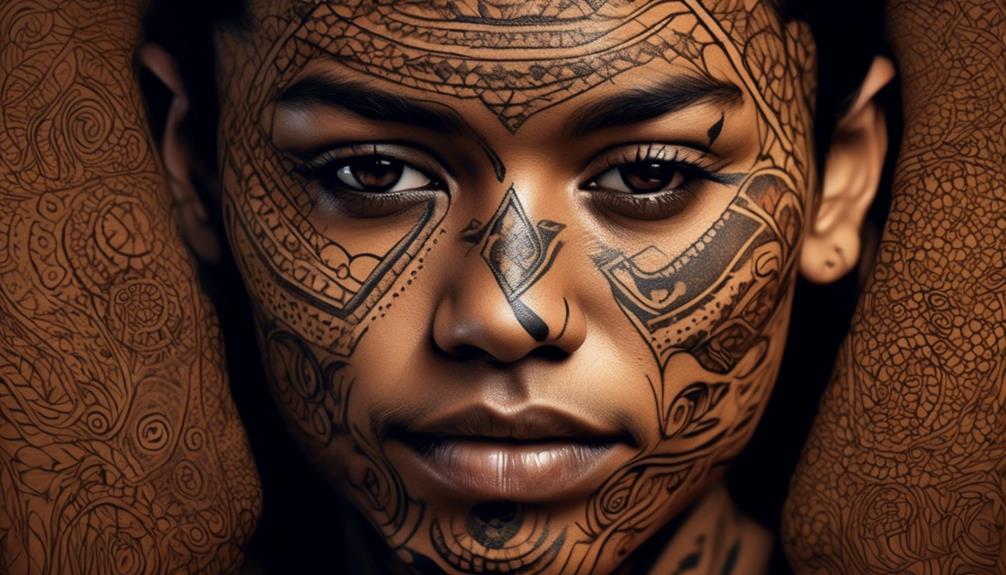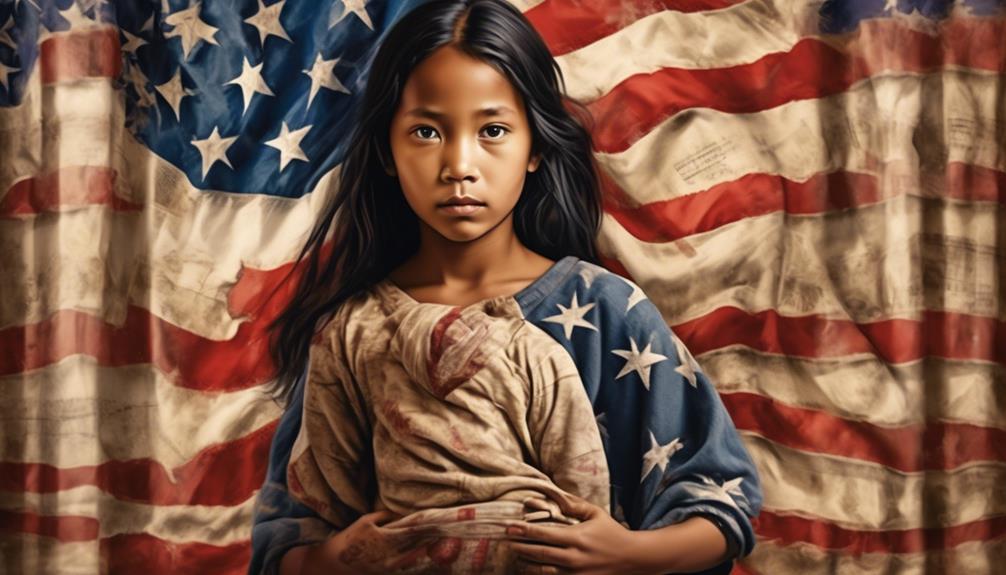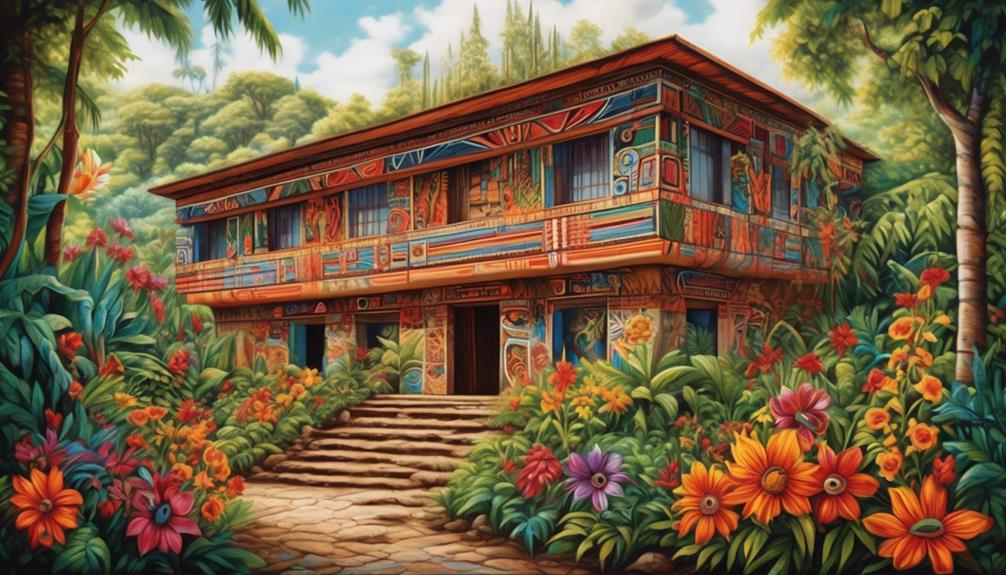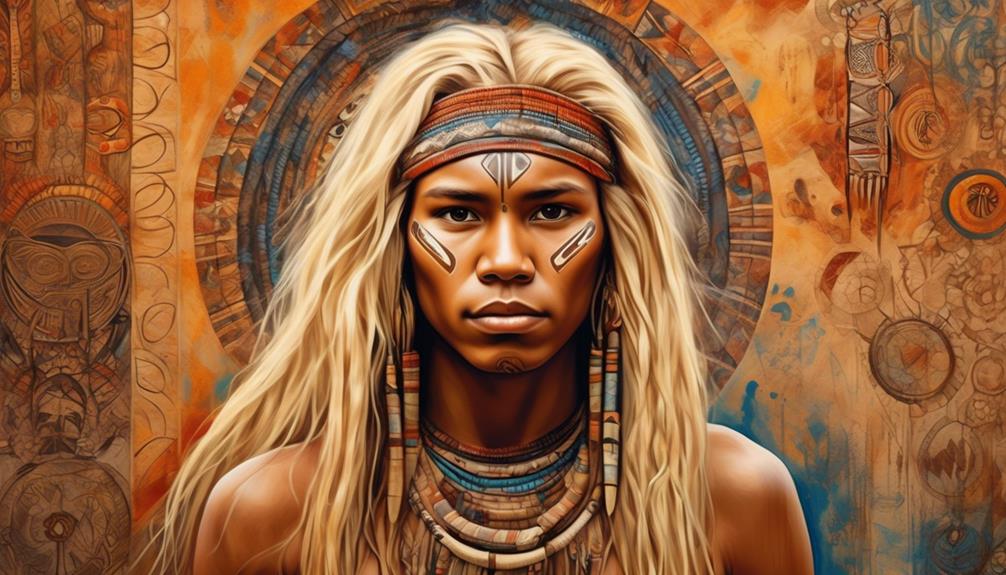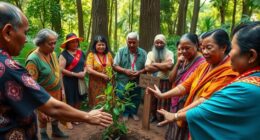When discussing Aboriginal tattooing, some believe that the traditional significance and cultural heritage of these tattoos have faded over time. However, delving into the history and importance of Aboriginal tattoo practices reveals a deep and complex tradition that is intricately connected to the cultural and spiritual identity of Indigenous communities.
From the traditional techniques and tools used in the process to the contemporary adaptations and revivals, the story of Aboriginal tattooing is a fascinating journey that sheds light on the enduring significance of these designs.
Key Takeaways
- Aboriginal tattooing is a practice that dates back thousands of years and is found among Indigenous groups worldwide.
- Traditional Aboriginal tattooing techniques involved hand tapping, piercing, and skin stitching, using natural materials like bone, wood, and plant thorns as tools.
- There has been a contemporary revival of Aboriginal tattooing, with artists incorporating traditional symbols into modern tattoo art and using different techniques like dotwork and watercolor effects.
- Aboriginal tattoos hold deep cultural and spiritual meanings, symbolizing a connection to the spiritual realms, conveying ancient wisdom, and reflecting personal growth and experiences.
History of Aboriginal Tattooing
The history of Aboriginal tattooing dates back thousands of years and holds profound cultural significance within Indigenous communities. Aboriginal tattooing is an ancient tradition that has been practiced by various Indigenous groups across the world, including the Maori of New Zealand, the Inuit of the Arctic, and the Indigenous peoples of Australia. These ancient traditions of tattooing were deeply rooted in spiritual and cultural beliefs, serving as a way to connect with ancestral spirits, depict stories of creation, and mark important stages in life such as puberty, marriage, and leadership within the community.
The art of Aboriginal tattooing wasn't only a form of self-expression but also a way to convey one's connection to the land, their tribe, and the spiritual world. Each symbol and design held specific meanings and was often unique to particular tribes or individuals. The techniques and tools used in Aboriginal tattooing varied among different Indigenous groups, with some utilizing traditional hand-tapping methods and natural pigments, while others used bone needles and charcoal for the tattooing process.
These ancient traditions of Aboriginal tattooing continue to be revered and preserved within Indigenous communities, serving as a reminder of their rich cultural heritage and deep spiritual connections.
Traditional Techniques and Tools
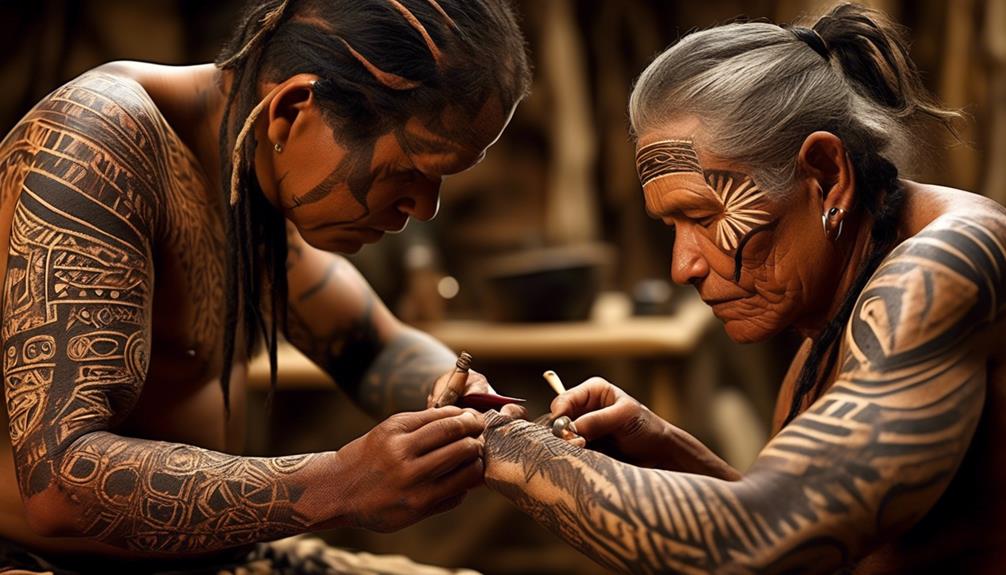
Exploring the intricate art of traditional Aboriginal tattooing, we uncover the diverse techniques and tools employed by different Indigenous groups to create their timeless and meaningful designs. Traditional methods of tattooing among Aboriginal communities often involve the use of natural materials to create the necessary tools. Indigenous groups across Australia have historically used techniques such as hand tapping, piercing, and skin stitching to apply tattoos. These traditional methods require specialized tools crafted from natural materials such as bone, wood, and plant thorns. The table below provides a glimpse into the traditional tools and techniques used by different Aboriginal groups:
| Indigenous Group | Technique | Tools |
|---|---|---|
| Yolngu | Hand tapping | Bone or wooden comb-like instrument |
| Torres Strait | Skin stitching | Bone needles and natural pigments |
| Maori | Piercing | Chisels made from albatross bone |
These traditional techniques and tools not only demonstrate the resourcefulness of Aboriginal communities but also highlight the cultural significance and spiritual nature of tattooing in Indigenous cultures.
Cultural and Spiritual Meanings
Deeply intertwined with the rich tapestry of Indigenous cultures, Aboriginal tattoos hold profound cultural and spiritual significance, reflecting the interconnectedness of identity, tradition, and ancestral wisdom.
The spiritual connection embedded within Aboriginal tattoos serves as a visual representation of the deep-rooted beliefs and values of the Indigenous peoples. These tattoos aren't merely decorative; they're imbued with layers of meaning that convey a profound sense of spiritual identity and connection to the natural world.
Artistic representation in Aboriginal tattoos often symbolizes a connection to the spiritual realms, serving as a medium through which individuals can express their relationship with the land, ancestors, and cosmic forces. The intricate designs and symbols used in these tattoos aren't only aesthetically pleasing but also carry profound spiritual meanings that are passed down through generations.
Furthermore, Aboriginal tattoos serve as a means of honoring and commemorating cultural traditions and spiritual rites, preserving and celebrating the sacred knowledge and wisdom of the Indigenous communities. They're a testament to the enduring spiritual resilience and cultural vitality of the Aboriginal peoples, encapsulating a profound sense of interconnectedness with the spiritual and natural world.
Contemporary Revival and Adaptations
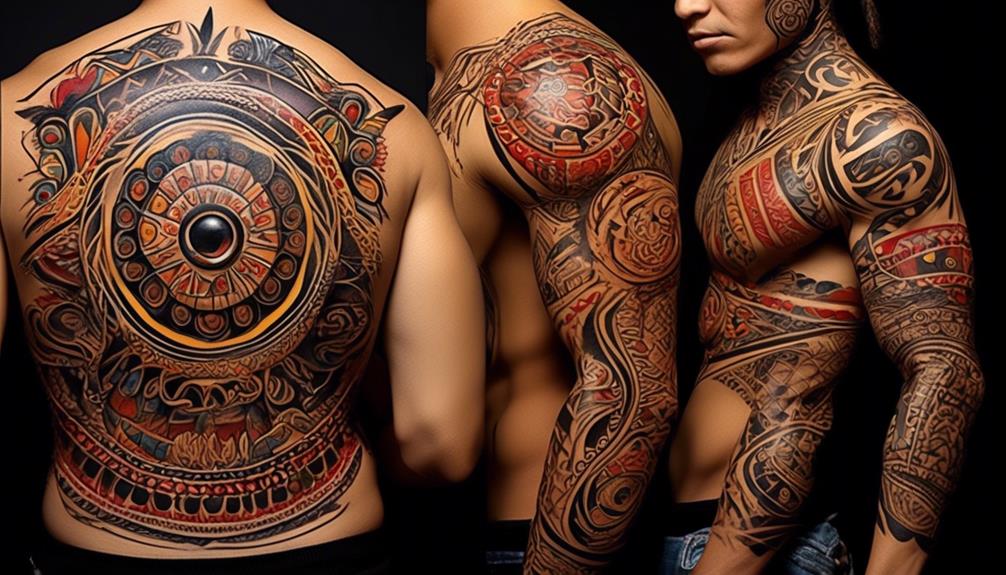
In recent years, there has been a notable resurgence of interest in Aboriginal tattooing, with contemporary artists and individuals embracing and adapting this traditional art form to express modern interpretations of cultural identity and spirituality. This revival has led to a fascinating array of artistic expressions, where traditional Aboriginal symbols and designs are being reimagined and incorporated into modern tattoo art. Here's a glimpse into the modern interpretations and artistic expressions of Aboriginal tattooing:
| Modern Interpretations | Artistic Expressions | Cultural Significance |
|---|---|---|
| Fusion of traditional Aboriginal motifs with contemporary tattoo styles | Experimentation with different tattooing techniques, such as dotwork and watercolor effects | Reflecting the interconnectedness of the present and the past, and the ongoing relevance of Aboriginal culture |
| Incorporation of personal and individualized elements alongside traditional Aboriginal designs | Creation of unique, personalized tattoos that honor individual experiences and connections to Aboriginal heritage | Highlighting the diversity and individuality within the Aboriginal community |
| Collaborations between Aboriginal and non-Aboriginal tattoo artists | Bridging cultural boundaries and fostering mutual respect and understanding | Promoting cultural exchange and appreciation for Aboriginal art and traditions |
The contemporary revival of Aboriginal tattooing not only celebrates the rich cultural heritage of Aboriginal communities but also demonstrates the adaptability and resilience of these traditions in the modern world.
Significance of Aboriginal Designs
Aboriginal designs carry profound cultural significance, embodying a rich tapestry of knowledge, spirituality, and interconnectedness within the Indigenous communities of Australia. These designs aren't merely decorative; they're deeply rooted in the cultural heritage and body art traditions of Aboriginal peoples.
Each symbol, line, and pattern holds layers of meaning, often representing stories of creation, navigation, and connection to the land. The significance of these designs is further heightened by their role in ceremonies and rituals, where they serve as a visual language, conveying ancient wisdom and spiritual beliefs.
Furthermore, the act of receiving these designs through traditional tattooing practices is a sacred and transformative process. It's a way of honoring one's ancestors, connecting to the past, and embracing one's identity within the community. The designs aren't static; they evolve with the individual, reflecting personal growth and life experiences.
This dynamic relationship between the individual and the cultural symbolism embedded in the designs underscores their enduring importance in Aboriginal communities. Therefore, the significance of Aboriginal designs goes beyond mere aesthetics; they're living expressions of cultural identity, spirituality, and interconnectedness.
Frequently Asked Questions
Are There Specific Rules or Guidelines for Non-Indigenous People Getting an Aboriginal Tattoo?
When it comes to cultural appropriation, ethical considerations are essential. It's crucial to be respectful and mindful of the cultural significance behind certain practices.
Non-indigenous individuals seeking an Aboriginal tattoo should educate themselves on the cultural significance and history of the design. It's important to approach the process with sensitivity and to consult with knowledgeable individuals within the community to ensure that the tattoo is obtained in a respectful and appropriate manner.
What Are Some Common Misconceptions About Aboriginal Tattooing?
Misconceptions about cultural practices can lead to cultural appropriation. It's important to respect traditional techniques and understand modern adaptations.
In our society, many misconceptions exist about various cultural practices, including tattooing. It's crucial to educate ourselves and approach these topics with sensitivity and respect.
How Has the Practice of Aboriginal Tattooing Evolved Over Time?
Evolution is a natural process that shapes everything, including cultural practices like tattooing. As time passes, artistic expression and modern influences contribute to the evolution of ancient traditions.
Understanding the cultural significance of these practices helps us appreciate their evolution over time. We can witness the transformation of traditional tattooing methods and designs as they adapt to contemporary influences, reflecting the dynamic nature of human expression and creativity.
Are There Any Taboos or Restrictions Related to Getting an Aboriginal Tattoo?
There are cultural sensitivities and taboos to consider when getting a tattoo from indigenous communities. It's important to respect the traditional significance of these tattoos and understand any restrictions or guidelines set by the community.
Cultural appropriation is a concern, so it's crucial to approach this practice with respect and understanding. Modern interpretations should also reflect this respect for the cultural context and significance of the tattoos.
What Are Some Ways in Which Aboriginal Tattooing Has Influenced Contemporary Tattoo Culture?
Influence from aboriginal tattooing has shaped contemporary tattoo culture in profound ways. The traditional symbolism and storytelling present in aboriginal tattoos have influenced modern tattoo artists to incorporate similar elements into their work.
However, it's important to recognize the fine line between influence and cultural appropriation. We must honor the origins of these practices and respect their significance in aboriginal culture.
Conclusion
In conclusion, Aboriginal tattooing has a rich history and deep cultural significance.
Did you know that traditional Aboriginal tattooing techniques date back over 5,000 years? This ancient practice continues to inspire contemporary tattoo artists and is a powerful way for Indigenous people to reclaim their cultural identity.
The designs and symbols used in Aboriginal tattooing aren't just beautiful, but carry important spiritual and cultural meanings that deserve recognition and respect.
